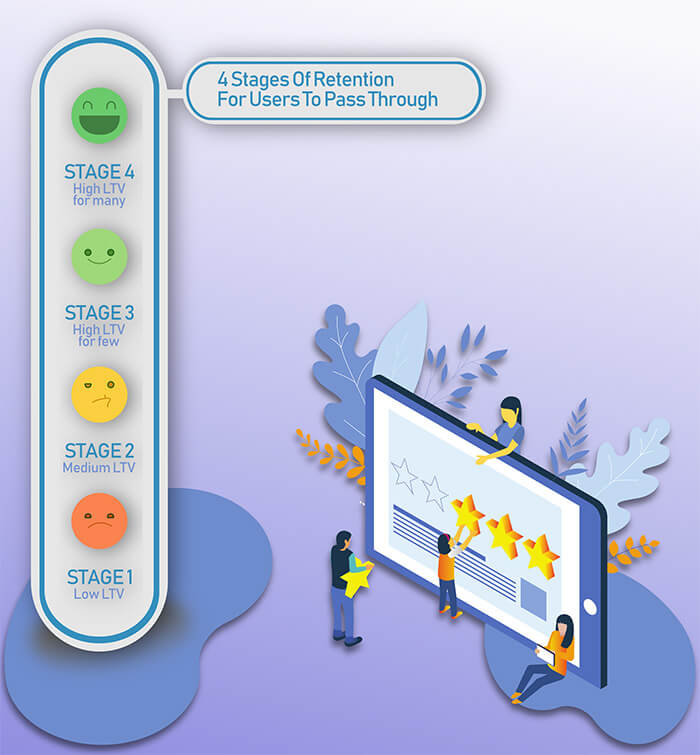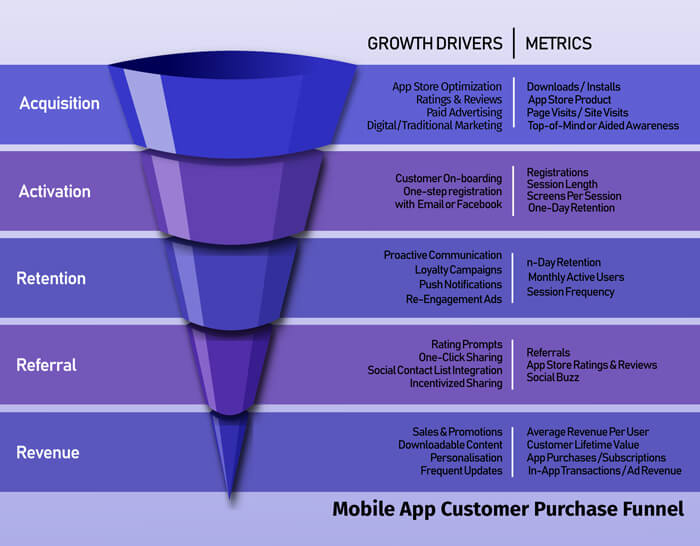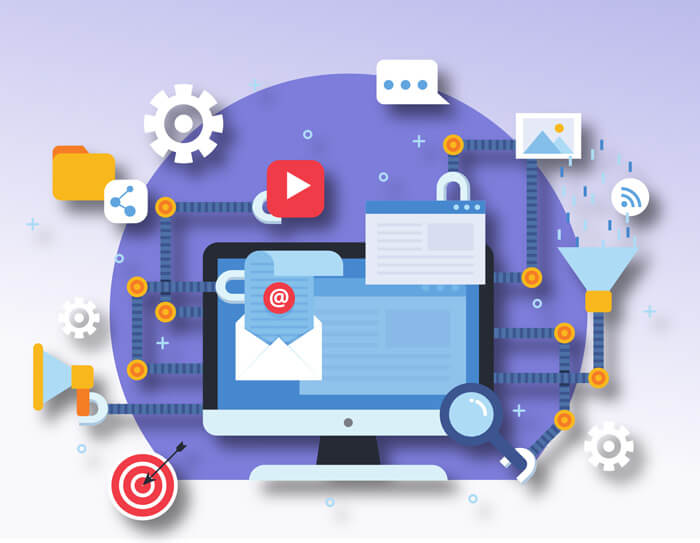The effectiveness of growth hacking in-app marketing is dwindling! In other words, mobile app retention has been sidelined for too long.
Over the years, product managers and marketers have been using this mantra to grow your business: Acquiring more users.
While this mantra may have helped you gain that initial traction for your app business, you may have soon realized that this cannot continue since your user acquisition costs eventually skyrocket, resulting in minimal ROIs.
The Problem?
The key problem is the definition of growth. It seems easy when you try to solve the problem of growth by thinking that you just need more users. Isn’t it?
Within 30 days, most mobile apps lose 90% of all their users.
There are way too many companies asking, “How do we acquire more users?” that should instead be asking “How do we get better at keeping the users we already have?”
Jamie Quint
This is exactly where user retention comes in.
Smart Questions to Ask Yourself:
- Will acquiring more users and multiplying your downloads alone help you maximize your company’s ROI?
- Has sending unsegmented push notifications and blast emails daily with offers and discounts to your entire user base helped in increasing revenue?
- How much time do you actually spend in planning your marketing activity and executing it?
- Does it cost you a lot to acquire a new user as compared to retaining an existing one?
User retention is crucial for mobile marketers. It is the leading indicator of your app business and a north star metric that helps in determining future success. It is important to allocate adequate resources and time to retaining your existing users as to acquiring new users.
Defining User Retention
User retention is the ability of a mobile-enabled business to retain its mobile app users over a period of time. In simple terms, user retention is getting your users to keep using your app.
“User retention is the ultimate measure of whether everything your mobile product, messaging, and overall experience is working.”
Hila Qu, VP of Growth at Acorns
User retention has to be the north star metric for data-driven marketers. According to Gartner, 80% of your future profits will come from just 20% of your existing users. For every user, you retain your profit grows by 1%.
In fact, increasing user retention by just 5% can increase profits anywhere between 25% and 95%. While developing the product is a major focus area for most startups, having a strong customer success team is another key area of focus. The average app loses 77% of its daily active users (DAUs) within the first 3 days after install.

When you think about marketing your mobile app, it’s a general tendency that your mind jumps straight to lead generation and user acquisition strategies that focus on attracting new users.
But mobile marketing isn’t just about acquiring new users, it’s also about retaining them. In fact, retention is more important than acquisition.
Acquisition vs Retention
There’s been a long debate on which mobile app marketing framework to follow. Most mobile marketers, even today, follow the “AARRR” model, which was devised by Dave McClure more than 10 years ago. This framework majorly focuses on user acquisition.
But there’s a massive problem with this framework in today’s hyper-growth world. It was written in 2007 when acquisition was cheap, and most key channels that are now saturated were easy to explore and scale.
The AARRR model is popular because it’s simple and highlights all the important elements of growth. It’s also popular because it’s built around every marketer’s favorite part of growth: Acquisition.

“If you only focus on Acquisition as a marketer today, you are just digging a hole for your mobile startup.”
Gabor Papp
While the acquisition is crucial in growing your mobile app business, your focus should gradually shift towards including more and more retention marketing in your marketing strategy.
Here’s how you might want to start thinking about retention:

What is Retention Marketing?
Retention marketing is a strategy that focuses on marketing to existing mobile app users. It brings back users to your mobile app who have already made conversions or performed a specific action.
It also markets to users who are connected to your business using a monthly/yearly recurring membership or subscription.
Why is Retention Marketing Important?
For emerging mobile-first businesses, a retention marketing strategy proves to be a smart strategy. The most unsuccessful mobile app businesses have worked hard to acquire new users but failed to retain them by not re-engaging and remarketing to them.
Retention marketing has proven to be extremely cost-effective and boosts your revenues while using fewer resources as opposed to acquisition marketing. Since we’ve already established that increasing your app user retention rates by 5% can increase your profits by as much as 95%, this is enough validation to understand how important retention is to your business.
Implementing retention marketing strategies in your marketing mix will help you increase profitability by:
- Increasing the LTV of users: By increasing the frequency of spends and actions of each user, your LTV gradually increases and so does the profitability
- Enabling new channels for sales: Now that your LTV has increased this opens up your scope for exploring newer channel of user acquisition
- Increased AOV: According to a study by Adobe, retained users make up for 40% of your sales which represents only 8% of them.
One of the most effective ways to implement retention marketing strategies is to use push notifications. Push notifications allow you to send personalized messages to your users, even when they are not using your app. You can use push notifications to notify users about new features or updates, send them personalized recommendations, offer them exclusive discounts or promotions, and alert them about important events or news.
Push notifications as a user retention strategy
Push notifications are a great way to re-engage users and bring them back to your app. You can use push notifications to:
Notify users about new features or updates
Send them personalized recommendations
Offer them exclusive discounts or promotions
Alert them about important events or news
Push notifications are a great way to re-engage users and bring them back to your app. You can use push notifications to:
- Notify users about new features or updates
- Send them personalized recommendations
- Offer them exclusive discounts or promotions
- Alert them about important events or news
How Can Marketing Automation Help You Overcome the Retention Roadblock?
Push notifications are a game-changer for user retention. Marketing automation will ensure marketers like you continue delivering amazing app user experiences. Marketing automation platforms like Netcore are built and designed specifically to drive higher user engagement and higher user retention via multiple channels, including push notifications.
It helps you understand your users, and analyze them and their usage patterns on a daily, weekly, and monthly basis. It also lets you leverage deep user insights to communicate with them at the best time to multifold your conversions using push notifications.

Here are 7 foolproof tactics to help you leverage marketing automation and push notifications to overcome your biggest roadblock:
1. Identify and onboard your app users
Marketing automation tools help you identify and segregate both anonymous users and registered users as well. It not only identifies but also automates your user onboarding process.
It further takes an incremental approach to activating your app users, which will help them see greater value in your business, improving retention over time.
2. Track and understand user behavior
When you’re building your app, you must’ve foreseen your target audience or who you’re building the app for. Behavioral data is extremely critical in today’s data-driven marketing.
Using behavioral cohorts, you can define a group of users based on their in-app actions and save them to predict their actions further. Understand how users engage with your browser push notifications and real-time notifications.
Pro Tip
Find which cohorts produce better retention rates to uncover possible reasons as to why.
Have you launched a new marketing campaign?
Did you A/B test your campaign creatives?
Did you offer a promotion or discount through push notifications?
Can it be attributed to the release of a new feature with web push notifications?
Did you add a video tutorial to your existing product tour?
Figure out what’s been working for you and double down on your retention efforts.
3. Segment users based on intent
If you’re a growth marketer, then you must know how critical segmentation is in marketing. You must segment your users based on various parameters, including their interaction with push notification tools, but not all segments bring predictability to your retention rates.
Start segmenting your user base based on their intent with your app, especially those who engage with your rich push notifications.
Save your predictions as campaign objectives, and Netcore will automatically create 3 micro-segments for you: users most likely, moderately likely, and least likely in order to meet your campaign objective.
Like any segment, these intent-based segments are used for targeted user journeys and campaigns through web and/or app push notifications.
For example: You’d want to put in more retention efforts to retain a segment of users that are completely dormant and are most likely to uninstall your app as opposed to the segment of users that are hyperactive and are least likely to uninstall your app. Sending contextual messages through real-time notifications to the right segment will improve your retention rates.
4. A/B test your push notifications
Automation helps you assess your users’ needs and preferences and the way you interact with them. A/B testing your push notifications, including rich push notifications, is a smart way to know what exactly is working and what is not.
As a data-driven marketer, let the data support and guide your marketing decisions. Send different variants of your push notifications to different user segments over time to gauge which variant is positively improving your app engagement and is able to quickly get your users to their “aha!” moment.
There are many elements to a push notification, including web push notifications, browser push notifications, or app push notifications, and each of them has the ability to impact your notification’s effectiveness. You can A/B test your push notifications based on:
- Type of Notification – Plain or Rich Push
- Type of Creative – Image or GIF
- Timing of the Notification
- Image or GIF Variants
A/B tests influence your campaigns by giving users the best experience, and a positive user experience is what leads to long-term user retention.
5. Scale up your engagement
Over a period of time, your user base will increase and there are certain tasks that you need to automate using a marketing automation tool.
It helps in sending marketing communications via multiple channels, such as push notifications, in-app messages, email, SMS, WhatsApp, etc. at scale. The objective is to attain the end results without compromising on the total number of users engaged, including those who interact with browser push notifications.
6. Trim over communication
Over communication always sets a bad example and may be perceived as privacy intrusion by your users. You don’t want your users to uninstall your app because of over-communication.
Decide on the number of notifications you need to send to your audience through your chosen push notifications service. This can also happen if you’re not using an intelligent marketing automation tool or if your users are not segmented.
The right mix of content and frequency will play a vital role in uplifting your retention rates using the right push notification strategies.
7. Strategize and design your marketing campaigns
Marketing automation tools allow you to strategize your marketing campaigns based on the user analytics that are available to you just a click away.
You can deep-dive into user analytics, understand a particular user behavior, and build campaigns accordingly. Smartech’s journey builder helps you create a conditional flow for your campaigns to be automated and run without your intervention, especially when dealing with the best push notification platforms.
Key Metrics to Keep Track of Retention Marketing
In order to maximize the outcome of your retention marketing efforts, you first need to understand what retention metrics to track and how to measure them. Once you have established them, you can begin to put them to work for lasting and profitable results.
1. Retention Rate
Retention Rate = 1 – Churn Rate
Tracking and measuring retention rates over a period of 1, 7, or 30 days helps determine the apps’ longevity in the market. Retention rates give you a bird’s eye view on what’s working and what needs improvement. It’s a continuous process that should begin after any significant changes in your app to reflect changes in user retention, including those influenced by web push notifications.

2. Churn Rate
Churn Rate is the number of users who have uninstalled your app or stopped using your app at any given period.
The formula for churn Rate = (No. of Users at the End of the Period – No. of Users at the Start of the Period)/No. of users at the Start of the period
3. Customer Lifetime Value (CLTV)
CLTV is one of the most important retention metrics to track as it gives you the actual monetary value of the customer that you have gained, especially when leveraging the best push notification platforms. This helps in building an effective loyalty program to identify how much you should spend to retain your most valuable customers with effective push notification marketing.
CLTV = APV (Average Purchase Value) x PF (Purchase Frequency) x CLT (Customer Lifetime)
Make Retention the King of Growth Strategy
User retention has to be on the forefront of your core marketing mix. Make retention the king of your growth strategy because –
“The point is, every improvement that you make to retention also improves all of these other things — virality, LTV, payback period. It is literally the foundation to all of growth, and that’s really why retention is the king.”
Brian Balfour, VP Growth, HubSpot
Start using a marketing automation tool to help you overcome your retention roadblock while leveraging the potential of push notifications, including web push notifications, push notification APIs, and browser push notifications through Netcore Cloud – the best push notification platform available







